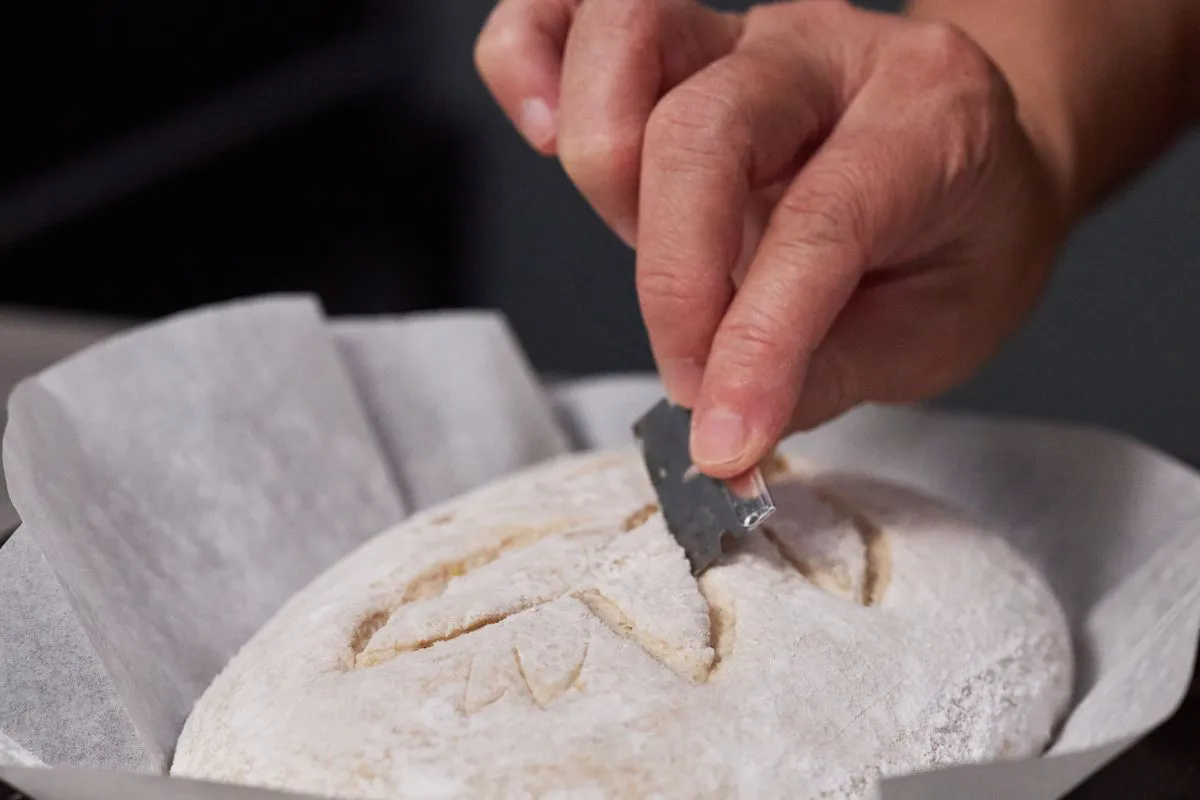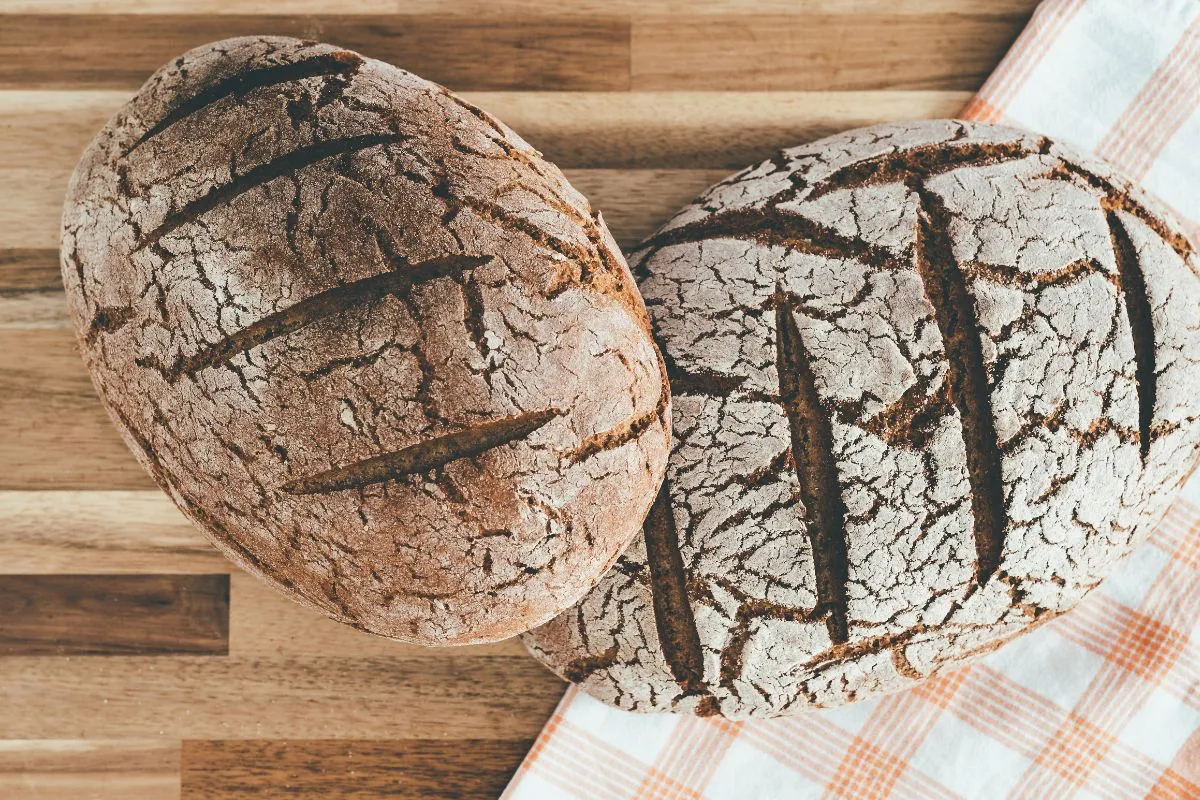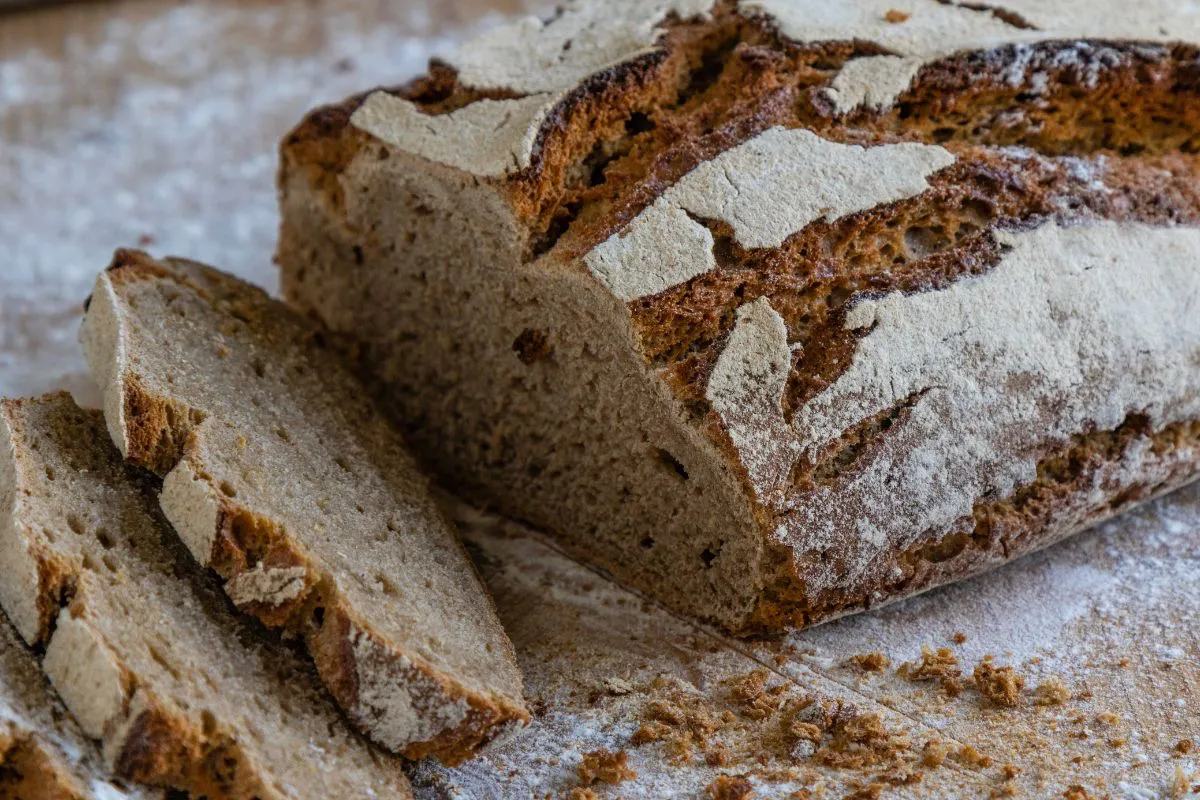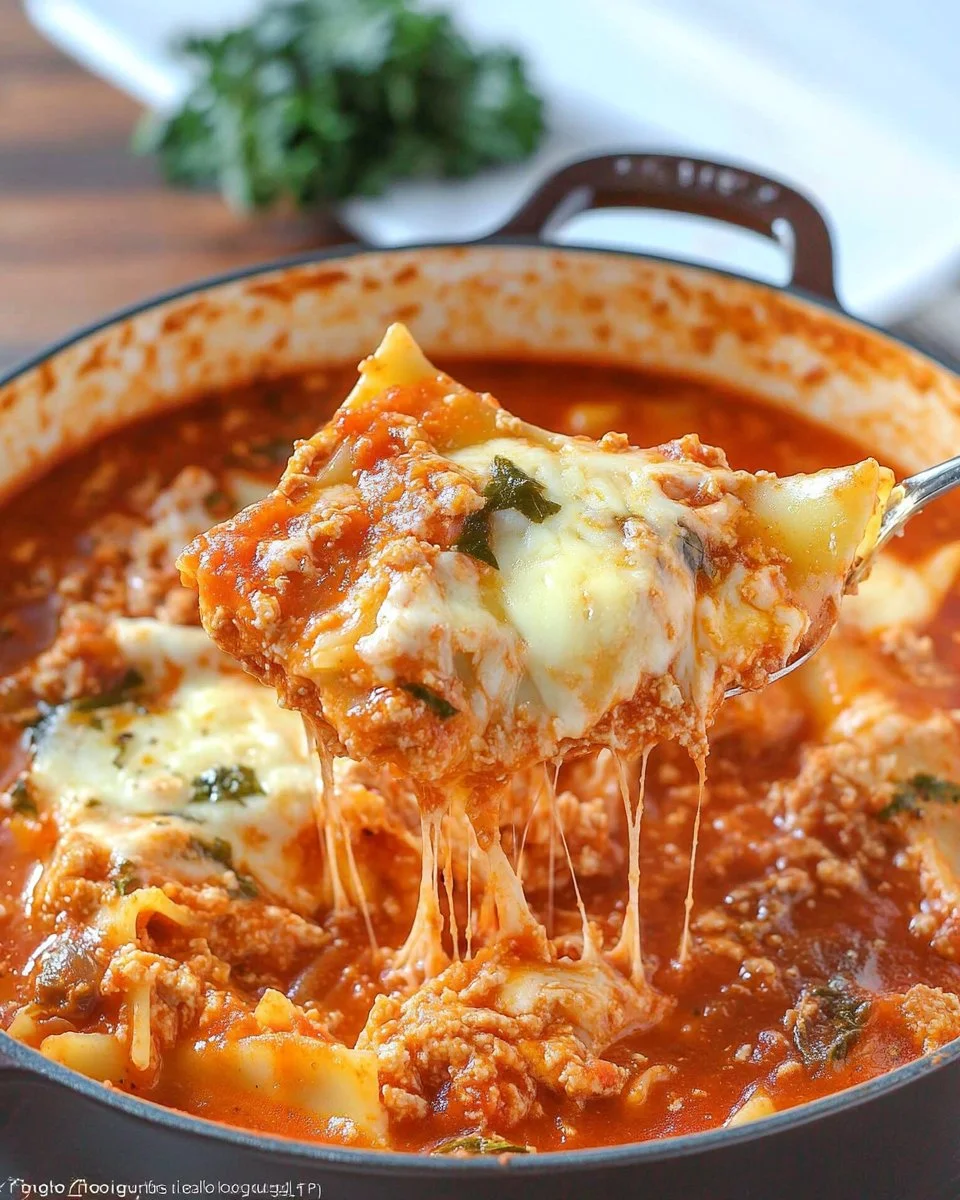Introduction to German Sourdough Rye Bread Recipe
There’s something truly magical about making your own bread, especially when it’s a traditional recipe like this German sourdough rye bread recipe. In fact, this bread is a staple in many German households, known for its dense texture, rich flavor, and health benefits. So, what makes it so special, and why should you give it a try? Let’s dive into the world of German sourdough rye bread and discover what sets it apart.
What Makes German Sourdough Rye Bread Special?
Use of Rye Flour and Sourdough Starter
The secret to this bread lies in its ingredients. German sourdough rye bread uses a blend of rye flour and a sourdough starter, which gives it that distinct, tangy flavor and chewy texture. Unlike other types of bread, rye flour is lower in gluten, making it denser and heartier. In addition, the sourdough starter, a natural leavening agent, not only helps the bread rise but also adds depth to the flavor.
Distinctive Taste and Texture of German Sourdough Rye Bread
One bite of this bread, and you’ll understand why it’s a favorite. The combination of rye and sourdough creates a unique flavor profile that’s slightly sour, deeply earthy, and wonderfully complex. Consequently, the texture is firm yet tender, perfect for slicing thin or thick, depending on your preference.
Health Benefits of Sourdough Fermentation
Moreover, aside from its taste and texture, this bread is also packed with health benefits. The fermentation process of the sourdough starter breaks down phytic acid, making the nutrients in the bread more bioavailable. Therefore, your body can absorb more vitamins and minerals from each slice. Plus, sourdough is easier to digest, making it a great option for those with sensitive stomachs.
Essential Ingredients for German Sourdough Rye Bread
List of Ingredients for Traditional German Rye Bread
To make this German sourdough rye bread recipe, you’ll need the following ingredients:
- 500g rye flour
- 200g sourdough starter
- 350ml water
- 10g salt
- 1 tbsp caraway seeds (optional)
Explanation of Each Ingredient’s Role in German Sourdough Bread
Each ingredient in this recipe is essential. The rye flour provides the base, while the sourdough starter acts as the leavening agent. Water hydrates the dough, salt enhances the flavor, and caraway seeds add an extra layer of taste that complements the rye perfectly.
Selecting the Right Rye Flour for German Sourdough Rye Bread
Types of Rye Flour for Authentic German Bread
When it comes to choosing rye flour, you have a few options: light, medium, and dark. Light rye flour has a milder flavor and is more refined, while dark rye flour is more robust and contains more of the bran and germ. Medium rye flour is a balance between the two, offering a good mix of flavor and texture.
Where to Buy Authentic Rye Flour for German Sourdough
Finding high-quality rye flour is essential for this recipe. You can find it at specialty baking stores, health food stores, or online. Explore rye flour baking techniques at King Arthur Baking for more tips and tricks.
Necessary Equipment for Baking
List of Required Baking Tools for German Rye Bread
To make this bread, you’ll need the following tools:
- Mixing bowl
- Dough scraper
- Proofing basket
- Baking stone or baking sheet
- An oven with a steam function or a tray for water
Importance of Each Tool in the German Sourdough Rye Bread Process
Each tool serves a purpose. The mixing bowl and dough scraper help you combine and knead the dough efficiently. The proofing basket supports the dough during its final rise, while the baking stone ensures an even bake. Furthermore, the steam function or tray of water in the oven creates the perfect crust.

How to Make a Sourdough Starter from Scratch for German Rye Bread
Step-by-Step Guide to Creating a German Sourdough Starter
Creating a sourdough starter is easier than you might think. Here’s a simple guide:
- Mix 100g of rye flour with 100 ml of water in a jar. Loosely cover and leave at room temperature for a full day.
- On day two, discard half of the mixture and add another 100g of rye flour and 100 ml of water. Mix well and cover.
- Repeat this process for 5-7 days until the starter is bubbly and has a pleasant sour smell.
Tips for Maintaining a Healthy Sourdough Starter for German Rye Bread
Maintaining your starter is key to great bread. Feed it regularly, at least once a week, and keep it in a cool, dark place. If you bake frequently, you can store it at room temperature; otherwise, keep it in the fridge.
Feeding and Storing Your Sourdough Starter for German Bread
How to Feed the Starter for German Sourdough Rye Bread
Feeding your starter is simple: discard half and replace it with equal parts rye flour and water. Mix well and let it sit until bubbly. Learn more about sourdough starters on The Perfect Loaf for detailed instructions.
Best Practices for Storing German Sourdough Starter
If you bake often, keep your starter at room temperature and feed it daily. For occasional baking, store it in the fridge and feed it weekly. When you’re ready to bake, bring it to room temperature and feed it a few times to reactivate it.
Combining Ingredients to Form the Dough
Step-by-Step Instructions for Mixing German Rye Dough
Now that your starter is ready, it’s time to make the dough. Here’s how:
- In a large bowl, combine 500g of rye flour, 200g of sourdough starter, 350 ml of water, and 10g of salt.
- Mix until a rough dough forms. It will be sticky; that’s okay.
- Cover the bowl and let it rest for 30 minutes to autolyze.
Importance of Hydration and Texture in German Rye Dough
Rye dough is different from wheat dough; it’s stickier and less elastic. Don’t worry if it feels different from what you’re used to. The high hydration helps the dough develop its structure and flavor.
Kneading Techniques for German Rye Dough
Effective Kneading Methods for Sourdough Rye Bread
Rye dough doesn’t require much kneading. Instead, use a folding technique:
- Wet your hands to prevent sticking.
- Gently stretch and fold the dough over itself a few times.
- Cover and let it rest for 30 minutes. Repeat this process 2-3 times.
Tips to Avoid Over-Kneading German Rye Dough
Over-kneading can make rye dough tough. Aim for gentle handling and let the fermentation do most of the work. This method allows the dough to develop its texture without overworking it.
Understanding the Fermentation Stages for German Sourdough Rye Bread
Primary Fermentation Details for German Rye Bread
After mixing and kneading, it’s time for the first fermentation. The dough should rise for four to six hours at room temperature, or until it has doubled in size. This slow rise allows the flavors to develop fully.
Importance of Time and Temperature in Fermenting German Rye Dough
Fermentation is a delicate process. Too much heat can speed up the fermentation, leading to overproofing, while too little can slow it down too much. Aim for a consistent, cool room temperature for the best results.
Shaping and Final Proofing of German Sourdough Rye Bread
Shaping the Dough Correctly for German Rye Bread
Once the dough has fermented, it’s time to shape it. Gently turn it out onto a floured surface and shape it into a round or oval loaf. Place it in a proofing basket, seam side up, and cover it with a cloth.
Techniques for Successful Proofing of German Sourdough Rye Bread
The final proofing stage is crucial. Let the dough rise for another 1-2 hours at room temperature, or until it has risen noticeably but still holds its shape. Discover tips for baking rye bread on Serious Eats for more insights.
Preparing the Oven for Baking German Sourdough Rye Bread
Optimal Oven Settings for German Rye Bread
Preheat your oven to 475°F (245°C) with a baking stone inside. If you don’t have a baking stone, a heavy baking sheet will work. To produce steam, put a tray of water at the bottom of the oven.
Using Baking Stones and Steam for Authentic German Rye Bread
The baking stone helps achieve an even bake, while the steam creates a crusty exterior. If your oven doesn’t have a steam function, the tray of water will do the trick. Steam is essential for a good crust.
Baking and Cooling Your German Sourdough Rye Bread
Step-by-Step Baking Instructions for German Rye Bread
- Carefully transfer the proofed dough onto a baking peel or the back of a baking sheet lined with parchment paper.
- Use a razor or sharp knife to score the top of the dough.
- Slide the dough onto the preheated baking stone and bake for 20 minutes.
- Reduce the temperature to 425°F (220°C) and bake for another 20-30 minutes, or until the crust is dark and the loaf sounds hollow when tapped.
Cooling Process and Why It Matters for German Rye Bread
Place the bread on a wire rack to cool entirely after baking. This allows the interior to set and the crust to firm up. Cutting into hot bread can result in a gummy texture, so patience is key.
Troubleshooting Common Issues with German Sourdough Rye Bread
Common Problems and Solutions for German Rye Bread
- Dense Bread: This can be due to underproofing or using too much flour. Make sure your dough has doubled in size during fermentation and use the right hydration.
- Cracked Crust: This often happens if the dough is too dry or the oven lacks steam. Ensure your dough is well-hydrated and create enough steam in the oven.
- Sour Taste: If the bread is too sour, it might have over-fermented. Reduce the fermentation time slightly.
Adjusting the Recipe for Different Climates
Baking bread can be affected by your local climate. In humid areas, you might need to use a bit more flour, while in dry areas, a bit more water. Adjust as necessary to achieve the right dough consistency.
Enhancing Your Bread’s Flavor
Adding Seeds and Spices to German Sourdough Rye Bread
For extra flavor, try adding caraway seeds, fennel seeds, or even some chopped nuts to the dough. These additions can enhance the taste and add a delightful crunch.
Experimenting with Different Rye Flour Ratios
You can experiment with the ratio of rye to wheat flour to find your preferred balance. A higher percentage of rye flour will yield a denser, more flavorful loaf. On the other hand, adding some wheat flour will lighten the texture.
How to Serve German Sourdough Rye Bread
Best Pairings and Toppings for German Rye Bread
This bread pairs beautifully with a variety of toppings. Try it with butter and jam for breakfast, or with smoked meats and cheeses for a traditional German sandwich. It’s also excellent with soups and stews.
Traditional German Serving Methods for Rye Bread
In Germany, it’s common to serve rye bread with hearty spreads like liverwurst or pickled herring. For a more modern twist, try it with avocado and a sprinkle of sea salt.
Storing and Preserving Your Bread
Proper Storage Techniques for German Rye Bread
To keep your bread fresh, store it in a paper bag or wrapped in a kitchen towel at room temperature. Avoid plastic bags, as they can make the crust soggy.
How to Keep Your Bread Fresh Longer
If you want to extend the shelf life, you can freeze the bread. First, slice it, then wrap the slices individually in plastic wrap and store them in a freezer bag. When ready to use, thaw at room temperature or toast slices directly from the freezer.
Frequently Asked Questions
Can I use whole grain rye flour for this recipe?
Yes, you can use whole grain rye flour, but it will result in a denser loaf. You may need to adjust the water content slightly to accommodate the extra fiber.
How long does it take to make a sourdough starter?
It typically takes about 5-7 days to create a fully active sourdough starter from scratch. The process involves daily feeding and monitoring for bubbles and a sour smell.
Why is my sourdough rye bread dense?
Therefore, dense bread can result from underproofing or using too much flour. Additionally, ensure your dough has doubled during fermentation and maintain proper hydration.
Can I add seeds to my rye bread dough?
Absolutely! Adding seeds like caraway, fennel, or sunflower seeds can enhance the flavor and texture of your bread. Mix them in during the initial dough preparation.
How do I store my homemade sourdough rye bread?
Store your bread in a paper bag or wrapped in a kitchen towel at room temperature to maintain its crust. For longer storage, freeze slices individually.
Conclusion
Firstly, baking your own German sourdough rye bread is not only a rewarding culinary adventure but also a way to connect with traditional German baking methods. Furthermore, this bread, with its distinctive taste and hearty texture, is perfect for any occasion—whether you’re enjoying a simple breakfast or creating a gourmet sandwich. By following this comprehensive guide, you’ll be able to produce a delicious and authentic loaf that reflects the rich heritage of German baking. Therefore, gather your ingredients, nurture your sourdough starter, and experience the joy of making this classic bread at home.







